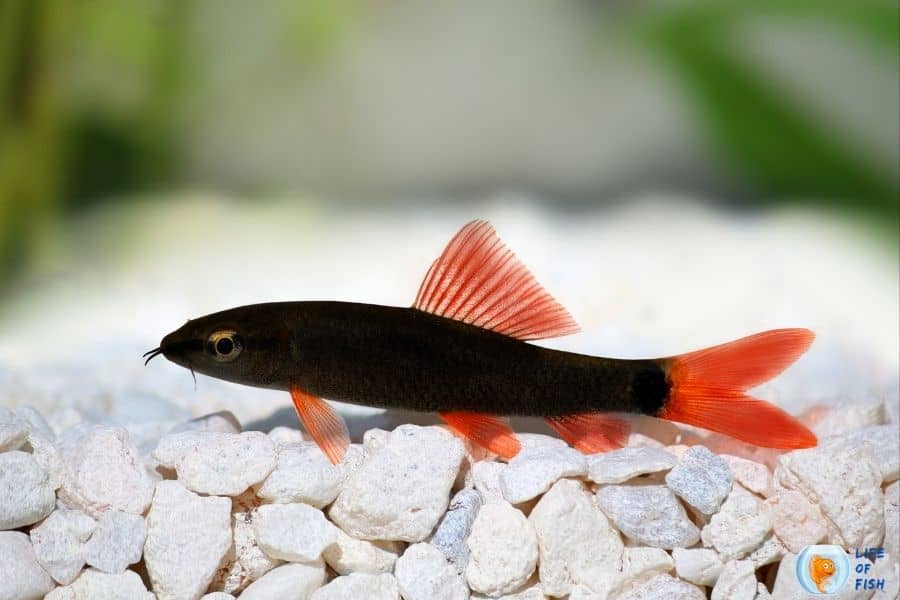There’s no doubt that rainbow sharks make the aquarium more vivid and colorful. Many aquarists love to keep these fish in their tanks as they are beautiful as well as they work as good tank cleaners. Are rainbow sharks aggressive? Yes and no.
Why do they act like that, and how to reduce the aggression of rainbow sharks? We’ll find out in the following post.

Are rainbow sharks aggressive?
Jump To
If you are talking about adult rainbow sharks, they are very aggressive because they are very territorial.
The truth is, if you put one baby rainbow shark in your tank, it won’t bother any other fishes because they are peaceful and stay in the bottom area of the tank.
But when they reach adult age, their aggression level becomes higher than before. And since they are bottom dwellers, they might want to protect their territory and chase their tankmates away.
Sometimes, they nip at other fish’s tails or fins, but it’s not a serious injury, and the injured fish will be fine in a while. If you put many adult rainbow sharks together, they will fight with each other to establish their territories.
The behavior of juvenile fish
Juvenile fish tend to be timid. Therefore, these juvenile fish spend most of their time hiding in rocks and caves. Because of this behavior, they don’t try to attack other fishes in the tank for any reason.
But, this peaceful behavior will continue only for several months as these fish become mature within one year of their life.
The behavior of matured fish
As rainbow sharks become mature, their behaviors also change. Mature rainbow sharks prefer to live in solitary and want an area of their own.
So, they become highly territorial and try to attack fish if other fish come near their territory, which is the bottom of the tank.
Even though you put only one rainbow shark in a tank, it will become aggressive as it tries to defend its territory.
So, what about the community tank with rainbow sharks? The answer is, you need to be prepared.
How to reduce rainbow sharks’ aggression?
If you want to keep these fish in a community tank, you need to separate them as soon as possible.
The sooner you do it, the better because they become highly aggressive as they grow older. The recommended rainbow sharks amount per fish tank is only one.
If you still want to keep a group of rainbow sharks together in one tank, the tank should be large enough that each fish gets at least one-meter range to establish its territory.
The minimum tank size for one rainbow shark is 55 gallons. For a group of 5 rainbow sharks, you need to have at least a 125-gallon tank with a long bottom.
You can reduce the aggression toward other fish by introducing your rainbow shark at last. For example, if you have gourami and a rainbowfish to put in with your rainbow shark, you should first place your gourami and rainbow fish in your aquarium.
The rainbow shark should be the last fish to introduce into your aquarium. This way, your rainbow shark will have fewer chances to claim the entire aquarium, which will help reduce their aggression.
You can also put more hiding places in your aquarium to keep your rainbow shark distracted from other fish. You can add rocks, caves, and even plants for this purpose.
This way, your fish will have more chances to save themselves if rainbow sharks try to attack, and your rainbow shark will eventually get away from your other fish.
Can we keep rainbow sharks in a community tank?
Yes. You can keep your rainbow shark in a community tank if it contains only compatible fish. Rainbow sharks have specific requirements when it comes to tank mates.
Bottom-dwelling fish
Rainbow sharks do not fare well with other bottom-dwelling fish, including rainbow sharks. As these fish are territorial, they will fight with any bottom-dwelling fish to establish their territory.
Therefore, you should never house them with other species of rainbow sharks or bottom-dwelling fishes like cichlids.
Upper and middle dwelling fish
Rainbow sharks do well with upper and middle-dwelling fish if they are powerful enough to defend themselves.
Some people say that rainbow sharks are aggressive toward other tropical fish like guppies, betta, and molly.
But, these fishes are not recommended in a community tank because guppies and mollies are livebearers.
Livebearers have a 30 days gestation period, which means you can get more baby guppies and mollies from one pregnant female within a month. Rainbow sharks may be aggressive toward these newborn fishes because they want to eat them.
In short, rainbow sharks do not become aggressive toward upper and middle dwelling fish as they don’t perceive them as threats.
However, if any fish goes near their territory (which means the bottom of the tank), these fish try to attack them to establish their territory.
Shrimps and Other invertebrates
As these creatures generally stay on the bottom of the tank, they don’t stand a chance to live with rainbow sharks because rainbow sharks consider them as their threats, and they will try to eat or kill them.
However, there’s an exception with snails. As snails are slow-moving animals, rainbow sharks do not see them as threats. So, snails can live happily with these fish.
Conclusion
Juvenile rainbow sharks are timid and not aggressive, while adult rainbow sharks are aggressive, even toward other rainbow sharks.
You should keep your adult rainbow shark in a community tank with other powerful fishes that can defend themselves from these sharks.
You should not keep your rainbow sharks with bottom-dwelling and livebearing fishes because these creatures may be attacked by them easily.
Read Next : Rainbow Shark Food | 3 Staple Food Items And 9 Snaks | Rainbow Shark Tank Mates (Can They Live With Other Fish? ) Albino Rainbow Shark (A Beautiful And Yet Aggressive Fish Care!)
